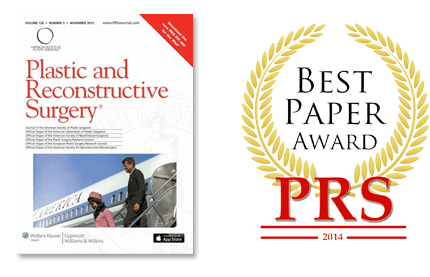The 2013 November issue of Plastic and Reconstructive Surgery, the official medical journal of the prestigious American Society of Plastic Surgeons (ASPS), published our most recent study on a new concept that harnesses the regenerative potential of fat grafting as an alternative to flap transfer. This technique developed at the Miami Breast Center gives hope to women who have suffered a failed flap transfer or are considering a flap reconstruction. To read the full article, click on the image on the right.
Abstract
Background: The application of a new approach is presented, percutaneous aponeurotomy and lipofilling, which is a minimally invasive, incisionless alternative to traditional flap reconstructions.
Methods: The restrictive subdermal cicatrix and/or endogenous aponeurosis is punctured, producing staggered nicks. Expansion of the restriction reconstructs the defect and creates a vascularized scaffold with micro-openings that are seeded with lipografts. Wide subcutaneous cuts that lead to macrocavities and subsequent graft failure are avoided.
Postoperatively, a splint to hold open the neomatrix/graft construct in its expansive state is applied until the grafts mature. Thirty-one patients underwent one to three operations (average, two) for defects that normally require flap tissue transfer: wounds where primary closure was not possible (n = 9), contour defects of the trunk and breast requiring large-volume fat grafts (n = 8), burn contractures (n = 5), radiation scars (n = 6), and congenital constriction bands (n = 3).
Results: The regenerated tissue was similar in texture and consistency to the surrounding tissues. Wider meshed areas had greater tissue gain (range, 20 to 30 percent). There were no significant wound-healing issues, scars, or donor-site morbidities. Advancement tension was relieved without flap undermining or decreased perfusion.
Conclusion: Realizing that, whether scar or endogenous fascia, the subder-mal aponeurosis limits tissue stretch and/or its three-dimensional expansion, a minimally invasive procedure that expands this cicatrix into a matrix ideally suited for fat micrografts was developed. Grafting this scaffold applies tissue-engineering principles to generate the needed tissue and represents a regenerative alternative to reconstructive flap surgery.
